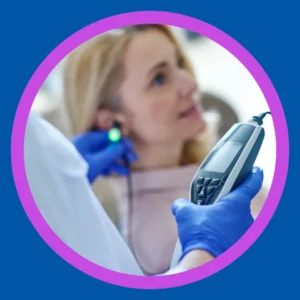Why Have Real Ear Measurement?
When you get hearing aids, you’re not just buying a device. You’re investing in your ability to communicate and connect. That’s why it’s critical they are fit correctly. One of the most powerful tools to ensure this is real ear measurement.
Real ear measurement is the gold standard in hearing aid fittings. It helps your hearing care provider tailor your hearing aids to the unique shape and size of your ear canal. This leads to better clarity, comfort, and long-term satisfaction.
If your provider isn’t doing this, you may not be getting the full benefit from your hearing aids.
What Is Real Ear Measurement?
Real ear measurement (REM), also called real ear verification, is a test that confirms how your hearing aid performs inside your ear. It uses a thin probe microphone placed in the ear canal to measure sound at the eardrum.
Every ear canal is different. Its shape and size affect how sound travels and is amplified. REM ensures that your hearing aids deliver the correct amount of amplification across different frequencies in your unique ear.
This allows your provider to adjust your devices with precision, not guesswork.
You can read more about the scientific foundation of REM in this systematic review, which highlights its impact on patient satisfaction and hearing clarity.

Why Hearing Aid Fittings Require More Than Guesswork
Many hearing aids come with “first fit” settings built into their software. These are average starting points based on general hearing loss data. But those settings don’t take your specific ear canal into account.
Studies show that manufacturer first fit settings typically under-amplify high-pitched sounds. These are the sounds that make speech clearer, such as “s,” “f,” and “th.” When you miss those, words sound muffled or incomplete.
Read more about hearing aid fittings to understand why a custom fit matters.
Only with real ear measurement can your hearing aids be fine-tuned to match evidence-based prescription targets, such as the NAL-NL2 or DSL formulas. This ensures that speech sounds are not only audible but also comfortable.
How Real Ear Measurement Works: Step by Step
Here’s what you can expect during a REM session:
Step 1: Visual Exam of Your Ears
Your provider will begin with an otoscopy. This is a visual check of your ear canal to make sure it’s clear of wax or blockages. Any obstruction could affect the measurement or damage the probe.
Step 2: Inserting the Probe Tube
A soft, flexible tube is inserted into your ear canal. It rests just a few millimeters from your eardrum. This may tickle, but it’s not painful.
Getting the placement right is essential. The tube must be close enough to the eardrum to give an accurate reading but not so deep that it causes discomfort.
Step 3: Placing the Hearing Aid
Your hearing aid is then placed in the ear along with the probe. This setup allows the provider to measure how the hearing aid’s sound is interacting with your ear.
Step 4: Playing Sound Samples
Next, you’ll hear a series of sounds or a recorded voice. Some clinics even use a friendly video clip. The sounds represent soft, average, and loud speech levels.
The probe measures how your hearing aid is amplifying these sounds at your eardrum. It generates graphs showing whether the device’s output matches your prescription targets.
Step 5: Making Adjustments
If your hearing aid is not hitting the targets, your provider adjusts the settings. The test is then repeated to confirm changes are effective.
This may take several iterations, but it ensures accuracy.
Step 6: Getting Your Feedback
Finally, you’ll be asked how things sound. If something is too loud, sharp, or muffled, your provider can make further refinements.
This step combines objective data with your personal experience. The result is a fitting tailored just for you.
Understand how healthy hearing contributes to healthy aging.
Benefits of Real Ear Measurement
Why go through all of this? Because it delivers real results. Here’s what you get:
Improved Speech Understanding
REM boosts clarity by ensuring all frequencies are amplified correctly. Patients fitted with REM hear better, especially in quiet environments where soft speech is harder to detect.
A Fit That Matches Your Anatomy
No two ears are alike. REM ensures your hearing aids are customized for the shape and size of your ear canal.
Fewer Return Visits
When the hearing aids are fit correctly the first time, you’re less likely to return for adjustments. This saves time and frustration.
Better Comfort and Satisfaction
REM allows your hearing aids to perform exactly as they should. That leads to more natural sound and better overall satisfaction.
More Confidence in Noisy Places
Although the gains in noise are more modest, patients often feel more confident and comfortable in challenging environments when REM is used.
How REM Compares to Live Speech Mapping
Many providers also use a process called Live Speech Mapping (LSM). Both methods involve placing a probe in your ear canal and both are used to verify hearing aid performance.
But there are key differences. Here’s a summary of what sets them apart:
- REM uses test tones or speech-like noise and adjusts settings between runs. It’s more precise but slower.
- LSM uses real speech and allows live adjustments. It’s more interactive and great for patient engagement.
Real Ear Measurement (REM) vs. Live Speech Mapping (LSM)
| Feature | Real Ear Measurement (REM) | Live Speech Mapping (LSM) |
Stimulus Type |
Uses non-speech signals like modulated noise or simulated speech (e.g., ISTS). These are standardized for measuring precise output levels at the eardrum. | Uses live or recorded speech, including the patient’s spouse or provider. This makes it feel more real-world and relatable to the patient. |
Adjustment Timing |
Adjustments are made between test runs. The provider tests, tweaks the settings in the software, then retests to confirm improvements. | Adjustments happen in real time as the provider watches how the speech stimulus is being amplified and makes changes instantly. |
Feedback Style |
Provides objective, data-driven output graphs showing gain and output levels at various speech intensities. | Provides visual feedback showing how actual speech sounds are processed and perceived through the hearing aid. |
Real-Time Visualization |
Limited visualization intended mostly for provider analysis. Patients rarely see the graphs unless the provider explains them. | High visual engagement. Patients and family can see the speech sounds and how they map onto their hearing profile live. |
| Measurement Method | Uses a thin probe tube inserted into the ear canal near the eardrum to measure actual sound pressure levels in the ear. | Also uses a probe tube, but focuses more on the live interaction aspect than just numeric precision. |
Common Usage |
Primarily used during initial fittings to verify the hearing aid meets prescriptive gain targets based on the audiogram. | Often used during follow-ups or counseling sessions to demonstrate benefit and improve patient confidence. |
Accuracy Level |
Extremely high. It’s the gold standard for ensuring hearing aids meet evidence-based targets like NAL-NL2 or DSL. | Also accurate, but slightly more flexible and subjective due to real-time adjustments and visual confirmation. |
Patient Engagement |
Low engagement during measurement. Patients mostly listen passively while data is collected. Feedback happens after the measurement. | High engagement. Patients see what’s happening and can provide immediate feedback, making them more involved in their care. |
Learning Curve for Provider |
Steep learning curve. It requires training to interpret data correctly and use both measurement and hearing aid software together. | Easier to learn and use, especially for providers who want to visually demonstrate hearing aid benefit. |
Use in Pediatric Fittings |
Essential. Children can’t reliably report how things sound, so objective measurements ensure proper development and access to speech. | Less common in pediatric care. It relies more on subjective feedback, which is difficult to get from young children. |
Both methods are valuable, and some clinics—including Stanford Hearing—use them together to ensure the best fit.

Who Should Get Real Ear Measurement?
The short answer is: everyone. But some groups benefit even more:
- First-time users need REM to build trust in their devices from day one.
- Children cannot describe how things sound. REM is essential for ensuring accurate speech access.
- People with severe hearing loss require precise fitting across a wide frequency range.
- Anyone struggling with their current aids may not have had REM before and could benefit from a proper verification.
Explore what causes hearing impairment.
Common Concerns (And Why They’re Not a Big Deal)
Some patients have concerns about the REM process. Here’s what to know:
- “Will it hurt?” No. The probe is soft, and placement is gentle. It might tickle, but that’s all.
- “Is it complicated?” Not for you. Your provider does the work—you just listen and give feedback.
- “Does it take a long time?” Not really. A full REM session typically adds 15–30 minutes to your fitting.
- “Why don’t all clinics do it?” Some avoid it due to equipment cost or training needs. At Stanford Hearing, we believe your care is worth the investment.
Real Science. Real Results.
The evidence is clear. Studies show that REM provides measurable improvements:
- A meta-analysis found that REM improves speech intelligibility in quiet and boosts patient preference by over 50%.
- REM-fitted users consistently report higher satisfaction and wear their devices longer.
- One study showed a 15% improvement in word recognition at soft levels when REM was used versus first fit alone.
These aren’t minor changes. They’re the difference between hearing “cat” and “cap,” or missing a child’s question entirely.
The Future of REM and Hearing Aid Technology
As hearing aid technology evolves, REM remains the foundation of proper fitting. Even as brainwave-measuring tools like CAEPs become more common in research settings, REM continues to offer the most accessible, evidence-based verification.
Modern REM systems are now faster, more intuitive, and include features like:
- Simulated speech signals (e.g., ISTS)
- Pediatric-friendly displays
- Wireless integration with hearing aid fitting software
Stanford Hearing keeps up with these advances to deliver the best care possible.

The Stanford Hearing Promise
We include real ear measurement in every hearing aid fitting because we believe you deserve the best. Your ears, hearing loss, and goals are unique.
We never guess. We test, measure, adjust, and verify—so your hearing aids work for your life, not someone else’s average.
Ready for Better Hearing?
Don’t leave your hearing aid performance to chance. Choose a provider who uses real ear measurement to ensure you’re hearing your best.
Contact Stanford Hearing today to schedule your custom fitting. Let’s take the guesswork out of better hearing—together.
